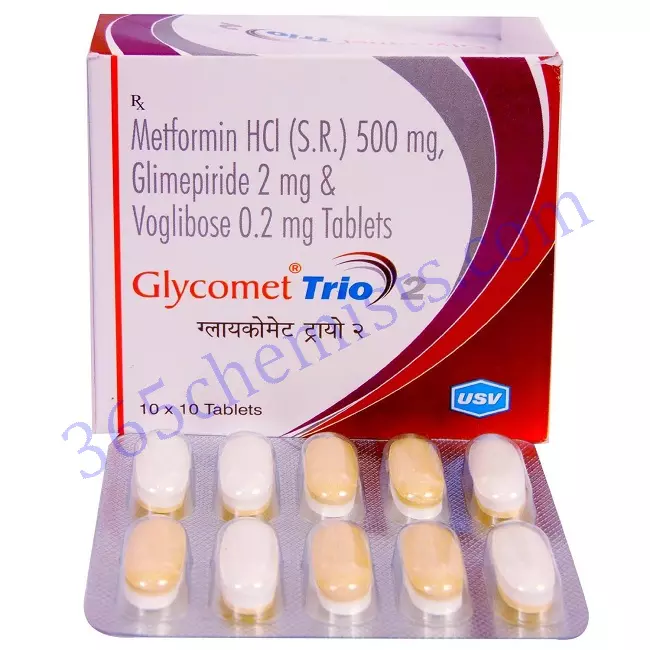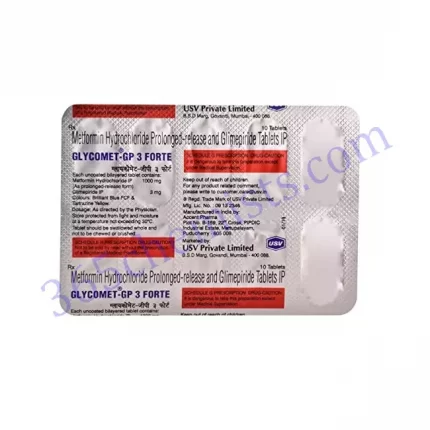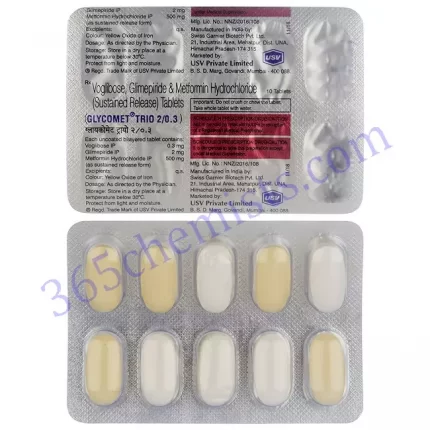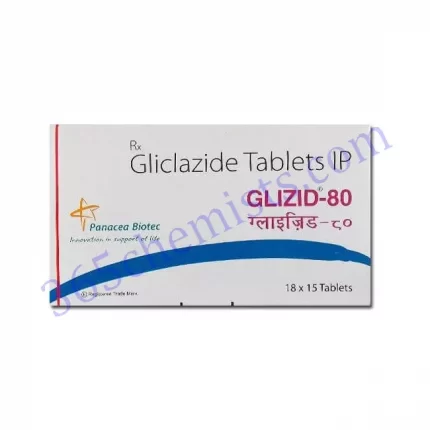An in-depth look at the medication combination of glimepiride, metformin, and voglibose found in the Glycomet Trio 2 tablet
glimepiride, metformin, and voglibose are the three active components that are included in the pharmaceutical preparation known as Glycomet Trio 2 Tablet. This tablet is recommended for the management of diabetes type 2, as it offers an all-encompassing method for regulating one’s blood sugar levels. The purpose of this article is to provide a comprehensive overview of Glycomet Trio 2, including the drug’s chemical make-up, mechanism of action, therapeutic applications, dose, potential adverse effects, and safety precautions.
Composition
The following three major components are included in each Glycomet Trio 2 Tablet:
- Glimepiride: Glimepiride is an oral anti-diabetic drug categorised as a sulfonylurea derivative. It accomplishes this by boosting the secretion of insulin from beta cells in the pancreas, which in turn lowers the amount of glucose in the blood. Glimepiride also enhances peripheral utilisation of glucose, aiding in glycemic management.
- Metformin is a biguanide chemical that is commonly utilised in the management and treatment of type 2 diabetes. It does this mostly by suppressing gluconeogenesis and glycogenolysis, which results in decreased glucose synthesis in the liver. In addition, metformin improves insulin sensitivity in peripheral tissues, which in turn encourages glucose absorption and utilisation.
- Voglibose is an example of an alpha-glucosidase inhibitor, which is the class to which it belongs. It achieves this effect by blocking the activity of the enzyme alpha-glucosidase, which is normally responsible for converting more complicated sugars into simpler ones. Voglibose helps reduce postprandial hyperglycemia by reducing the pace at which carbohydrates are digested and absorbed in the body.
The Workings of the Mechanism
In order to provide comprehensive glycemic control, the Glycomet Trio 2 Tablet combines the mechanisms of action of the diabetes medications glimepiride, metformin, and voglibose. Glimepiride is able to promote the release of insulin from the pancreas, particularly in response to glucose levels that are associated with meals. By taking this approach, postprandial hyperglycemia can be mitigated, and overall glycemic control can be enhanced.
Metformin primarily works to lower levels of glucose in the blood while the body is fasting. It does this by inhibiting glucose synthesis in the liver and increasing insulin sensitivity in peripheral tissues. It does this by inhibiting gluconeogenesis and glycogenolysis in the liver, which ultimately results in lower levels of blood sugar. In addition to this, muscle cells are better able to take in and use glucose when metformin is present.
Because it acts as an alpha-glucosidase inhibitor, voglibose slows down the digestive process and absorption of carbohydrates in the intestines. The enzyme alpha-glucosidase, which is responsible for breaking down complex carbs into simpler sugars, is inhibited by it. Voglibose helps manage postprandial blood glucose levels by slowing the digestion of carbohydrates; as a result, the danger of glucose rises following meals is reduced.
Related Product
Glycomet 250 Tablet
Glycomet 500mg Tablet
Glycomet 850mg Tablet
Glycomet 850 SR Tablet
Glycomet 1gm Tablet
Glycomet 1gm SR Tablet
Glycomet GP 0.5 Tablet
Glycomet GP 1/500mg Tablet
Glycomet GP 2/500 Tablet
Glycomet GP 2/850 Tablet
Glycomet GP 2 Forte Tablet
Glycomet GP 3 Forte Tablet
Glycomet GP 4 Forte Tablet
Glycomet GP 0.5/1000mg Forte Tablet
Glycomet GP 1/1000mg Forte Tablet
Glycomet GP 3/850mg Tablet
Glycomet Trio 1 Tablet
Glycomet Trio 1/0.3 Tablet
Glycomet Trio 2 Tablet
Glycomet Trio 2/0.3mg Tablet
Glycomet Trio Forte 1 Tablet
Glycomet Trio Forte 2 Tablet
Utilisations in Medicine
The treatment of diabetes mellitus type 2 is the primary purpose for which the Glycomet Trio 2 Tablet is recommended. When monotherapy with glimepiride, metformin, or voglibose alone is unable to control a patient’s blood glucose levels properly, a doctor may give this medication instead. An improved method of diabetes management and reaching optimal levels of glycemic control can be attained by the use of all three of these drugs together.
Indications and Methods of Administration
It is recommended that a healthcare practitioner establish the appropriate dosage of Glycomet Trio 2 Tablet for each individual patient based on unique patient factors such as age, renal function, and overall health state. It is absolutely necessary to take the medication exactly as directed, including in terms of dosage and administration. To ensure correct absorption and to lessen the likelihood of metformin causing gastrointestinal adverse effects, the tablet is often swallowed with a meal. This helps to lower the risk of side effects.
It is crucial to monitor blood glucose levels on a consistent basis in order to determine how effectively the medicine is working and to make any required modifications to the dosage.
The possibility of adverse effects
Glycomet Trio 2 Tablet, like any other medicine, has the potential to produce adverse effects in certain people. The following are some of the most frequently reported adverse effects connected with this medication:
- Effects on the Gastrointestinal Tract It is possible that some people will develop issues with their gastrointestinal tract, including nausea, bloating, flatulence, diarrhoea, and stomach discomfort. These adverse effects are, in most cases, modest and quite temporary.
- Hypoglycemia: Because glimepiride is a sulfonylurea, it has the potential to cause hypoglycemia, also known as low blood sugar levels. There is a possibility that you will have symptoms such as sweating, dizziness, trembling, confusion, and blurred vision. Consuming a source of glucose that acts quickly in the body is an effective way to correct hypoglycemia as quickly as possible.
- Reactions of the Skin: Although it is uncommon, some people may develop skin reactions such as a rash, itching, or hives. It is essential to seek medical assistance as soon as possible if any changes to the skin appear.
Precautions
It is imperative to take into consideration the following warnings and precautions before to beginning therapy with Glycomet Trio 2 Tablet:
- Because of the risk of allergic reactions, people who are aware that they are hypersensitive to sulfonylureas, biguanides, alpha-glucosidase inhibitors, or any of the other components of the pill should not take it.
- Metformin is mostly eliminated through the kidneys, making renal impairment a potential side effect. Adjusting the dosage or taking extra precautions is important when treating patients with renal impairment or severe renal dysfunction because of this.
- Hepatic Impairment: Patients with liver disease may require cautious monitoring while using Glycomet Trio 2, since these patients may be more sensitive to the effects of the medication. In the case of these individuals, a change to the dosage might be required.
Conclusion
A comprehensive strategy for the management of diabetes type 2 is provided by the Glycomet Trio 2 Tablet, which combines the therapeutic benefits of glimepiride, metformin, and voglibose. This combination drug provides enhanced glycemic control by acting on many areas of glucose regulation, insulin sensitivity, and the digestion of carbohydrates. For the treatment to be effective, it is essential to take the given dosage, report any unwanted effects in a timely manner, and take any and all precautions that may be necessary. It is vital to confer with a healthcare practitioner in order to ascertain whether or not Glycomet Trio 2 is appropriate for specific individuals and to address any concerns or questions pertaining to the manner in which it should be utilised.












